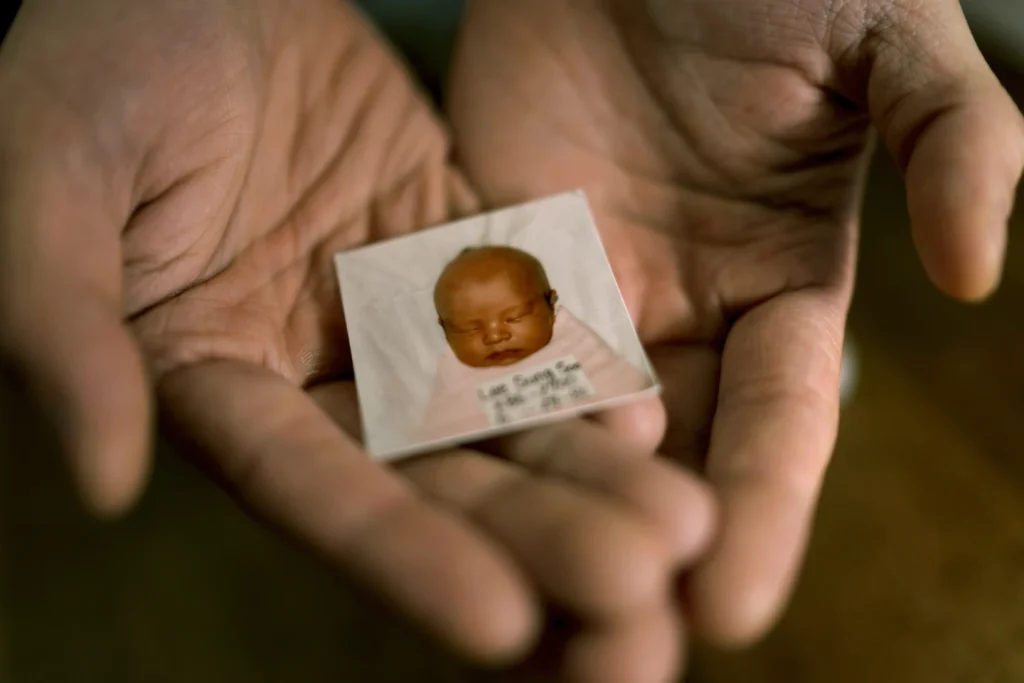The phenomenon of international adoption has often been framed as a benevolent act, a means of providing needy children with loving families in prosperous countries. In many cases, this narrative holds true, with countless individuals and families formed through adoption.
However, beneath the surface of this ostensibly noble enterprise lies a complex and fraught history, particularly in the context of South Korea.
The story of Robert Calabretta illustrates the profound emotional and ethical challenges associated with international adoption, revealing a system that has, at times, perpetuated significant injustices against adoptees and their birth families.
As Robert Calabretta’s plane descended into Seoul, the weight of an enormous journey bore down upon him. Swaddled in a blanket, he adopted a fetal position, symbolizing the life he was about to revisit after three decades.
Calabretta’s tears reflected a tumultuous mix of emotions: anticipation, fear, and a deep sense of loss. He was set to meet his biological parents for the first time, a reunion marked by revelations that would alter his understanding of his identity and origins.
For much of his life, he had been led to believe that his parents had abandoned him. Yet, upon locating them, he uncovered a harrowing truth: they had been misled into believing their infant had died due to a severe illness, a tragic twist that highlights the devastating consequences of a system designed to facilitate international adoptions.
Calabretta’s narrative is not an isolated incident but part of a broader pattern associated with the South Korean adoption system, one that has systematically prioritized the needs of prospective adoptive parents over the welfare of the children and families involved.
According to an investigation conducted by The Associated Press, approximately 200,000 Korean children were adopted internationally between the 1950s and the 2000s through a combination of government endorsement and actions by private adoption agencies.
While many adoptions were legitimate and well-intentioned, the investigation uncovered alarming practices, including child trafficking, coercive infant relinquishment, and the fabrication of documents to obscure the true nature of adoptions.
The implications of these revelations are profound, as they challenge the prevailing narrative surrounding international adoption.
For many adoptees, the emotional fallout of discovering that they were not simply orphaned children waiting for families, but rather victims of an exploitative system, is a source of deep trauma.
The emotional stakes are high; Calabretta expressed a poignant sentiment in recognizing that he felt he had been stolen rather than saved.
His story echoes the experiences of many adoptees who have undertaken the arduous journey of searching for their biological families, seeking answers that a flawed system has often obscured through falsehoods and inadequate documentation.
A striking aspect of the AP investigation is the extent to which various stakeholders—adoption agencies, the South Korean government, and Western countries—colluded in a system that prioritized the availability of children over ethical practices.
Documentation obtained by the AP revealed that agencies actively sought out children, sometimes employing questionable methods such as buying newborns from hospitals or persuading impoverished parents to relinquish their children under false pretenses.
This competitive market for adoption fueled a rapidly growing industry motivated by profit rather than the humanitarian principles often cited as justifications for international adoptions.
In light of these deeply troubling practices, it is essential to consider the structural and systemic changes necessary to rectify the injustices experienced by adoptees like Calabretta.
The formation of a fact-finding commission by the South Korean government in response to international pressure from adoptees represents a crucial step towards accountability.
However, while such initiatives may bring some measure of closure to those individuals directly affected, the question remains: how can we prevent similar abuses in the future?
Transparency, rigorous oversight, and the prioritization of adoptee rights over the interests of adoption agencies and prospective parents are essential to reforming the system.
One cannot overlook that not all adoptions are fraught with such controversies. Advocacy for adoption often emphasizes the positive outcomes for many children and families navigating the adoption process.
Yet, the conversation must remain inclusive of those whose voices have been marginalized—the adult adoptees who have uncovered painful truths about their origins.
It is not enough for the industry to celebrate the successful stories; there must also be acknowledgment and rectification of the harm caused to those who have borne the weight of an unjust system.
As global societal norms evolve and conversations around ethics and accountability in adoption continue, the perspectives of adoptees must be at the forefront of policy discussions.
Their stories, like Calabretta’s, serve as vital reminders of the need for reform and re-examination of the institutions that have historically governed and facilitated adoption practices.
Only through embracing a holistic understanding of adoption—one that recognizes the complexity of human relationships and the emotional realities faced by those involved—can we hope to foster a system that genuinely serves the best interests of children, their families, and society at large.
The convergence of societal desires and governmental policies surrounding child adoption in South Korea during the latter half of the 20th century illuminates the stark contrasts between affluent nations in the West seeking to fill their homes with children and South Korea’s pressing drive to mitigate the burdens of poverty and overpopulation.
As access to birth control and legalized abortion burgeoned, adoptable infants became a scarce commodity, thus intensifying the yearning of wealthy couples for children.
In this context, the South Korean government, compelled by both domestic and international pressures, began to shift its focus from foreign-born biracial infants to those it deemed less desirable: impoverished children and offspring of unwed mothers.
This pivot raised ethical concerns, as evidenced by the practices of adoption agencies that appeared to prioritize financial gain over child welfare.
Allegations arose regarding the manipulation and coercion of birth mothers for relinquishment, alongside accusations of systemic corruption and a lack of meticulous oversight in the adoption process.
Notably, Patricia Nye, a prominent director for the International Social Service, criticized South Korea’s policies as “entirely irresponsible,” likening the nation’s adoption practices to a “baby factory,” and asserting that this facilitated an alarming “trade in children” to Western households desperate for connection and family.
Despite governmental efforts to present the adoption framework as organized, internal memos contradict this facade, revealing a calculated attempt to accommodate foreign demand while sidestepping accountability.

With the enactment of laws that stripped judicial oversight and empowered private agencies, the South Korean state effectively sanctioned a system that thrived on the commodification of vulnerable children.
The stark ethical implications of this scenario evoke a critical examination of the intersectionality of socio-economic disparities and cultural perceptions of family, ultimately culminating in a legacy that raises pressing questions regarding the morality and humanity of child adoption practices both then and in the contemporary landscape.
In conclusion, the narrative surrounding South Korean adoption, as exemplified by Robert Calabretta’s experience, unveils a dark chapter in the history of international adoption.
While the desire to provide loving homes to children in need is commendable, it must be tempered by ethical considerations and a commitment to integrity.
As the international community grapples with the ramifications of these findings, it is imperative to advocate for a transparent and compassionate adoption system that honors both the rights of birth families and the dignity of adoptees.
Only then can we begin to heal the wounds inflicted by a legacy rooted in exploitation and misconception, striving instead towards a future that values genuine connections over transactional arrangements.
